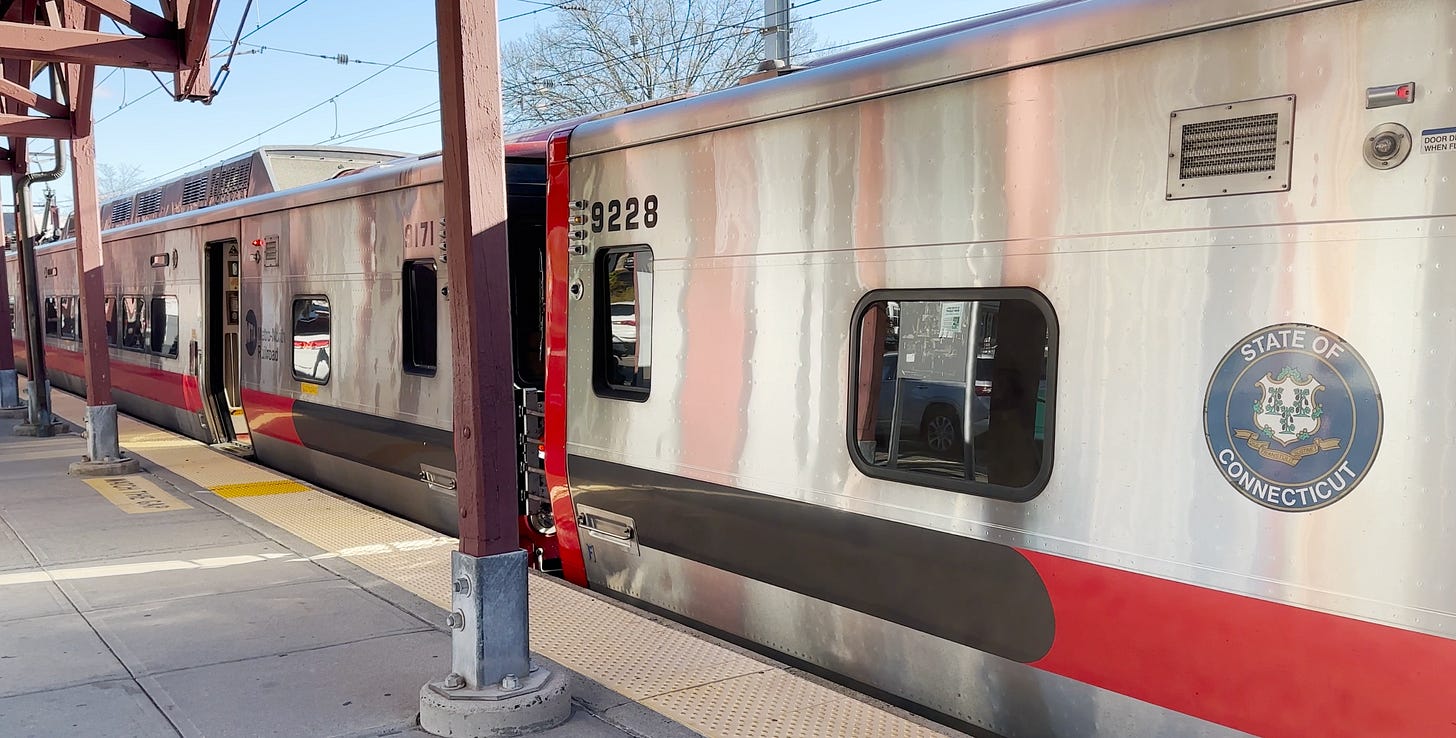A Ride On Metro-North's New Canaan Branch
The 8.2 mile New Canaan Branch should be the model for Metro-North's branch lines
On November 12th, 2024, I rode the New Canaan Branch from New Canaan, CT, to Stamford, CT.
The 8.2 mile, 17 minute stretch is the smallest branch of the New Haven Line consisting of just four stations: New Canaan, Talmadge Hill, Springdale, and Glenbrook.
New Canaan Station is quaint; upon arrival you’re greeted with a sign hanging on the platform that reads “New Canaan: The Next Station To Heaven”. Although there’s only one platform, it’s long enough for multiple train doors to open, unlike some stations on the New Haven Line. Inside the station, a cozy, well-kept room serves as refuge from possible inclement weather. On one side of the room sits a charming old-fashioned shoe shining stand. Across the way is a ticket counter with a small screen showing train departures.
The New Canaan branch uses Kawasaki M8’s, the same railcar used on CTrail’s Shore Line East (New Haven to New London), and Metro-North’s New Haven Line (Grand Central to New Haven). For comparison, the New Haven Line’s 28 mile Waterbury Branch and 23 mile Danbury Branch use the older Shoreliner coach.
After boarding the train we crept out of the station slowly, crossing Grove Street much to the displeasure of drivers. Many that live near the New Canaan Branch have complained of noise pollution by train horns. Local officials have considered installing new gates and fences to establish “quiet zones” but need to secure the funding to do so.
Southwest Fairfield County, home of the New Canaan Branch, holds some of the wealthiest towns in the United States. Nearly every passenger on the train was wearing business attire, most likely working in Stamford or taking a connecting train to Manhattan. This is a noticeable difference from the other two branches of the New Haven Line, whose ridership pulls from more diverse economic backgrounds. Traveling on the New Canaan Branch feels like a choice rather than a necessity for its passengers, who can most likely afford other modes of transportation. The Waterbury Branch and Danbury Branch serve as irreplaceable modes of transportation for many locals. When flooding shut down the Waterbury Branch for nearly ten weeks, additional buses were added to the schedule to fill the demand for commuters. On its first day back in service, trains on the Waterbury Branch were bustling with passengers - you can click to read about or watch my trip on the Waterbury Line.
The short 17 minute journey gives passengers a Zillow-like experience: quickly passing by houses that you can’t afford. Through the trees in Darien you can spot Woodway Country Club’s pristine golf course and new pickleball court. Regardless of the ritzy neighborhoods along the New Canaan Branch, graffiti can be spotted on a few lonely fences along the tracks, giving the branch the character that other branches throughout the tri-state area provide.
The New Canaan Branch has been a staple in southwest Fairfield County for over a century; the first train to New Canaan was in 1868. Since then, the branch has had many operators before Metro-North took over in 1983. There have been multiple accidents on the New Canaan Branch throughout its long history. One of the most notable occurred on August 20th, 1969, when two trains collided near Darien, killing two and injuring 40. Seven years later on July 13th, 1976, two trains collided, killing two and injuring 29.
The New Canaan Branch is an efficient and useful mode of transportation for Fairfield County. Its shuttle-like service provides many opportunities for commuters to get back and forth from Stamford to New Canaan. My thoughts on the branch can be summarized in context to the two other New Haven Line branches.
In 2023, The New Canaan Branch had over 600,000 riders, about 300,000 more than the Danbury Branch, and 500,000 more than the Waterbury Branch. In terms of growth, The Waterbury Branch’s ridership increased by 16.8% from the previous year. The Danbury Branch grew by 39.2%, which is the highest percentage of growth across all MTA lines by a large margin. With other branches having promising post-pandemic growth, MTA should use the New Canaan Branch as the goal for improving the Waterbury and Danbury Branches in the future.
For more on my short journey, watch my youtube video below:







